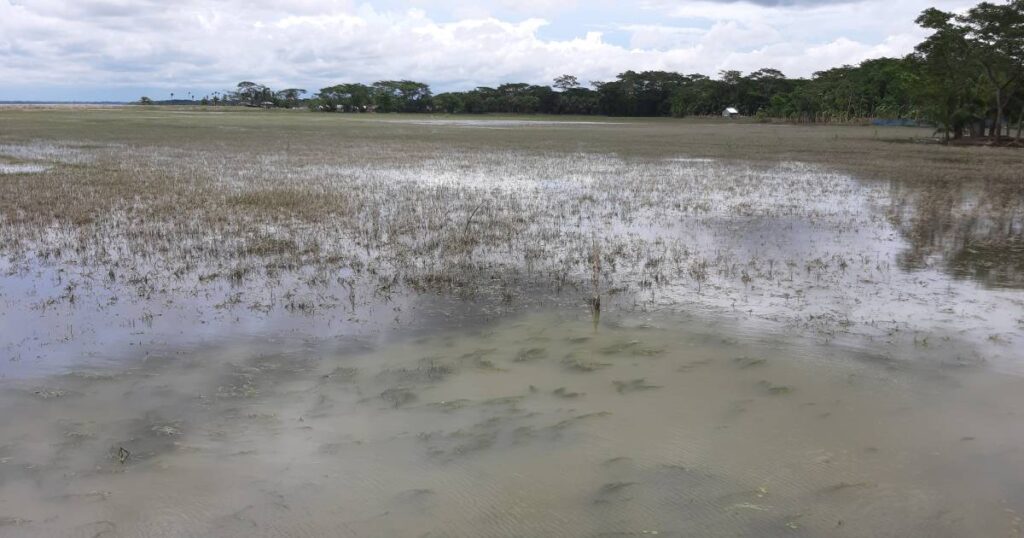Bagerhat, July 21 – The farmers of Sharankhola Upazila of Bagerhat district are frustrated with higher soil salinity affecting their crop lands since Cyclone Amphan ripped through the country on May 20, leaving a vast tract of land unfit for crop cultivation. The rise in sea levels associated with climate change meant creeping salinity over time was already known to be a long-term problem for farming croplands in the coastal districts. Extreme events such as cyclones that may not cause many human casualties can still leave behind lasting damage as they cause tidal surges in those areas, acting to cause spikes in salinity.
The saline water from the Bay has entered into the crop lands and fields of the Upazila due to the collapse of the ring embankment along Baleshwar River during the cyclonic storm Amphan, creating waterlogged situations in many areas. Though the local administration has taken initiative to pump out the saline water, a lot of the salinity is embedded in the soil, leading to long-term damage and decrease of soil quality.
According to the sources of the Department of Agriculture Extension (DAE), if the salinity stays for a long period of time inside the ground, the nature of biodiversity and crops might be damaged and there will be a risk of damage of soil.
According to the DAE, Aman paddy and rabi-crops can tolerate salinity up to 6-7 Electrical conductivity (EC) decicimen/m but the authorities concerned have found 35-36 decicimen/m on the lands of the Upazila due to the amphan. The salinity can be reduced through the rain water, they said.
Talking to local farmers, they said most of the lands in the Upazila have been brought under Aman paddy and Rabi-crops cultivation in a year due to absence of fresh water and now farmers are busy with aman seedbeds.
Farmers fear that due to excess salinity, the production of crops including Aman paddy, rabi-crops and vegetables will be affected. They also demanded cooperation of the government so that they can recoup their losses, caused by the amphan.
Harun Hawladar, a farmer of Bogi village in the Upazila said “One acre land of mine has been submerged due to the collapse of the embankment on the night of Cyclone Amphan and saline has developed on my land gradually. I used to cultivate paddy in that land which is now turned into saline land. Now I’m worried about how many years I will be able to produce crops on the land.”
Anwar Hossain, another farmer of Chaltebunia village, said “I have four bighas of land and it is the source of the livelihood of my six-member family. As saline water entered into my land during cyclone Amphan it turned into saline land.”
He also feared that it is not possible to grow any crop on the land.
Nazrul Islam, a village doctor said most of the people of the Upazila are depend on cultivation and the soil of many lands have lost its fertility due to saline water.
Mohammad Mamunur Rashid, the deputy commissioner of Bagerhat District, said “There is a possibility of facing some problems due to the salt water that got stuck on the croplands. The local administration is trying to remove salinity from the soil.”
In order to compensate for the loss, discussions have been held with the Department of Agriculture Extension for the cultivation of salt tolerant crops on the lands, he said.
Raghunath Kor, deputy director of Bagerhat DAE, said “Saline water has entered into the crops lands in Sharankhola, Morelganj and Mongla Upazilas of the district. The production of crops may be hampered due to excessive salinity in the lands. It is long-term damage. Strategies have been taken to recoup losses by cultivating salt tolerant crops.”
He also asked farmers to cultivate the salt-tolerant ‘73’ variety paddy on their lands.
According to the DAE, there are 1,39,958 hectares of cultivated land and salt water has entered on 500 hectares of land in Sharankhola, Mongla, Morelganj and Sadar Upazilas of Bagerhat, damaging 1,510 hectares of Aush paddy, banana, betel leaf and vegetables during the cyclonic storm Amphan, which made landfall in the coastal districts of the country on May 20.
Some 67,431 farmers involved with cultivation have been affected by the cyclonic storm.




